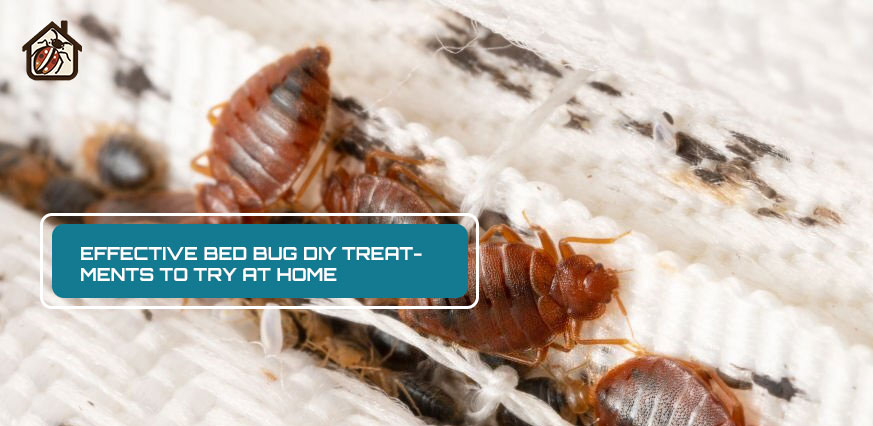
Effective Bed Bug DIY Treatments to Try at Home
Battling Bed Bugs: The Do’s and Don’ts of DIY Treatments
You and your loved ones may endure ongoing pain as a result of a bed bug infestation, so it makes sense that you would want to look into every possible method of getting rid of the problem. Dealing with a bed bug infestation can be a nightmare. These tiny, elusive pests can turn your haven of rest into a haven of distress. While professional pest control services are always an option, many people opt for a DIY approach to tackle these unwanted guests.
In this article, we’ll explore the do’s and don’ts of bed bug DIY treatments, helping you take effective action while avoiding common pitfalls.
Bed Bugs – Warning Signs

Bed Bugs – Warning Signs
The Cimicidae family includes tiny parasitic insects known as bed bugs. Although they may eat other warm-blooded creatures as well as humans, they are blood-feeding pests that prey mostly on people. It can be challenging to find and get rid of these insects because of their propensity for hiding in cracks, crevices, and other obscure locations. Here are some warning signs that can indicate a bed bug infestation:
- Unexplained Bites: Wake up with itchy, red bites often in lines or clusters.
- Rust-Colored Stains: Small bloodstains on sheets, pillowcases, or mattresses.
- Dark Fecal Spots: Tiny blackish spots on bedding or nearby furniture.
- Musty Odor: Unusual sweet, musty smell in the bedroom.
- Visible Bugs or Shells: Reddish-brown, apple seed-sized bugs or shed exoskeletons.
- White Eggs and Shells: Tiny, white eggs and translucent eggshells in hidden areas.
- Live Bugs in Seams: Active bed bugs in seams or crevices.
- Clear-White Nymphs: Newly hatched nearly transparent nymphs.
- Clusters of Bites: Bites on exposed skin, like face, neck, and arms.
- Molted Skins: Shed exoskeletons in crevices and hiding spots.
The Do’s and Don’ts of DIY Treatment
Do’s:
- Thorough Inspection: Before diving into any treatment, start with a comprehensive inspection. Carefully examine your mattress, bed frame, headboard, and other furniture in the vicinity. Look for tiny reddish-brown bugs, tiny white eggs, or small blackish fecal spots.
- Declutter and Clean: Clutter provides bed bugs with numerous hiding spots. Declutter your living space to minimize these hiding spots. Vacuum your mattress, carpets, and furniture regularly to reduce the population.
- Wash and Dry: Wash your bedding, curtains, and clothing in hot water, followed by high-temperature drying. Bed bugs can’t withstand high heat, so this can help eliminate them.
- Sealing and Isolating: Encase your mattress and box spring in bed with bug-proof covers. This prevents bed bugs from infesting these areas and makes them easier to detect. Also, move your bed away from walls and other furniture to make it harder for bed bugs to reach you.
- Natural Remedies: Some natural remedies like diatomaceous earth and essential oils (lavender, tea tree, and peppermint) can deter bed bugs. These remedies can be used as supplementary measures alongside other treatments.
Don’ts:
- Overusing Pesticides: While pesticides might seem like a quick fix, overusing them can be harmful to your health and may lead to pesticide resistance in bed bugs. Always follow instructions and use them sparingly.
- Ignoring Other Areas: Bed bugs are skilled hitchhikers. If you focus solely on your bedroom, they might spread to other parts of your home. Inspect and treat sofas, chairs, and even electrical outlets.
- Incomplete Treatment: Consistency is key. A one-time treatment won’t eradicate bed bugs. Repeat your chosen treatment method regularly to ensure you’ve eliminated all stages of the infestation.
- Moving without Precautions: If you’re considering moving to escape an infestation, be cautious. Bed bugs can easily hitch a ride on your belongings. Inspect and treat your items before moving to prevent carrying the infestation with you.
- DIY Bombs and Foggers: DIY foggers and bug bombs can disperse bed bugs, making the infestation worse. These products often don’t reach hidden crevices where bed bugs hide, giving them a chance to regroup and come back stronger.
You may also like:
FAQs
Q: How can I identify a bed bug infestation?
Q: Can I tackle bed bug infestations with DIY treatments?
Q: How effective are natural remedies for bed bug control?
Q: Can I eliminate bed bugs with a one-time treatment?
Q: Can I prevent bed bug infestations in the future?
Q: What if I'm unsure about the presence of bed bugs?
Conclusion
Taking on a bed bug infestation with a DIY approach can be effective if done correctly. Remember, thoroughness and consistency are your allies. By following the do’s and avoiding the don’ts, you can increase your chances of successfully tackling the infestation and reclaiming your home sweet home from these pesky intruders. If the infestation persists or worsens, don’t hesitate to seek professional help for a comprehensive solution.
